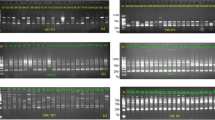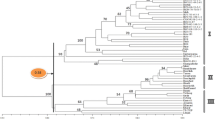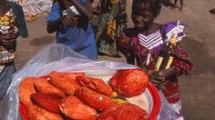Abstract
Baobab (Adansonia digitata L.) is one of the predominant tree species in West African agroforestry systems. A local morphological classification system is used by farmers, identifying trees with desired or undesired combinations of traits. This study evaluates the genetic significance of these morphotypes by comparing local identification with AFLP marker information. Eight morphotypes were recognized by seven ethnic groups from Benin, Ghana and Senegal, among 182 sampled baobab trees. Five primer pairs were used for DNA fingerprinting, resulting in a total of 254 scored bands, of which between 94.1% and 100% was polymorphic within morphotypes. Generally, genetic fingerprinting did not correlate with the traditional morphological identification of Adansonia digitata. Probably, AFLP markers are not directly linked to the differences in phenotype or the traits used for the traditional classification are largely dependent on environmental factors. Since no genetic differentiation is found between the morphotypes, a morphotype-based approach in the collection of genetic variation for conservation programs is not advisable.

Similar content being viewed by others
References
Aldrich PR, Hamrick JL, Chavarriaga P, Kochert G (1998) Microsatellite analysis of demographic genetic structure in fragmented populations of the tropical tree Symphonia globulifera. Mol Ecol 7:933–944. doi:10.1046/j.1365-294x.1998.00396.x
Assogbadjo AE, Sinsin B, Van Damme P (2005a) Caractères morphologiques et production des capsules de baobab (Adansonia digitata L.) au Bénin. Fruits 60(5):327–340. doi:10.1051/fruits:2005039
Assogbadjo AE, Sinsin B, Codjia JTC, Van Damme P (2005b) Ecological diversity and pulp, seed and kernel production of the baobab (Adansonia digitata) in Benin. Belg J Bot 138(1):47–56
Assogbadjo AE, Kyndt T, Sinsin B, Gheysen G, Van Damme P (2006) Patterns of genetic and morphometric diversity in baobab (Adansonia digitata L.) populations across different climatic zones of Benin (West Africa). Ann Bot (Lond) 97:819–830. doi:10.1093/aob/mcl043
Assogbadjo AE, Glèlè Kakaï R, Chadare FJ, Thomson L, Kyndt T, Sinsin B, et al (2008) Folk classification, perception and preferences of baobab products in West Africa: consequences for species conservation and improvement. Econ Bot 62(1):74–84. doi:10.1007/s12231-007-9003-6
Bye R (1993) The role of humans in the diversification of plants in Mexico. In: Ramamoorthy TP, Bye R, Lot A, Fa JE (eds) Biological diversity of Mexico: origins and distribution. Oxford University Press, New York
Borghetti M, Leonardi S, Raschi A, Synderman D, Tognetti R (1993) Ecotypic variation of xylem embolism, phenological traits, growth parameters and allozyme characteristics in Fagus sylvatica. Funct Ecol 7:713–720. doi:10.2307/2390193
Codjia JTC, Fonton-Kiki B, Assogbadjo AE, Ekue MRM (2001) Le baobab (Adansonia digitata), une espèce à usage multiple au Bénin. CECODI/CBDD/Veco/SNV/FSA, Cotonou
Codjia JTC, Assogbadjo AE, Ekué MRM (2003) Diversité et valorisation au niveau local des ressources forestières alimentaires végétales du Bénin. Cah Agric 12:321–331
Delisle H, Bakari S, Gevry G, Picard C, Ferland G (1997) Provitamin A content of traditional green leaves from Niger. Original title: Teneur en provitamine A de feuilles vertes traditionnelles du Niger. Cah Agric 6(8):553–560
Diop AG, Sakho M, Dornier M, Cisse M, Reynes M (2005) Le baobab africain (Adansonia digitata L.): principales caractéristiques et utilisations. Fruits 61(1):55–69. doi:10.1051/fruits:2006005
Gebauer J, El-Siddig K, Ebert G (2002) Baobab (Adansonia digitata L.): a review on a multipurpose tree with promising future in the Sudan. Gartenbauwissenschaft 67(4):155–160
Geleta N, Labuschagne MT, Viljoen CD (2006) Genetic diversity analysis in sorghum germplasm as estimated by AFLP, SSR and morpho-agronomical markers. Biodivers Conserv 15:3251–3265. doi:10.1007/s10531-005-0313-7
Heaton HJ, Whitkus R, Gomez-Pompa A (1999) Extreme ecological and phenotypic differences in the tropical tree chicozapote (Manilkara zapota (L.) P. Royen) are not matched by genetic divergence: a random amplified polymorphic DNA (RAPD) analysis. Mol Ecol 8:627–632. doi:10.1046/j.1365-294x.1999.00616.x
IPGRI (1999) Vers une approche régionale des ressources génétiques forestières en Afrique sub-saharienne. Actes du premier atelier régional de formation sur la conservation et l’utilisation durable des ressources génétiques forestières en Afrique de l’Ouest. Afrique Centrale et de Madagascar, Ouagadougou, Burkina-Faso
Jaccard P (1908) Nouvelles recherches sur la distribution florale. Bull Soc Vaud Sc Natur 44:223–270
Katajima K, Mulkey SS, Wright SJ (1997) Seasonal leaf phenotypes in the canopy of a tropical dry forest: photosynthetic characteristics and associated traits. Oecologia 109:490–498. doi:10.1007/s004420050109
Kelly BA, Hardy OJ, Bouvet J-M (2004) Temporal and spatial genetic structure in Vitellaria paradoxa (shea tree) in an agroforestry system in southern Mali. Mol Ecol 13:1231–1240. doi:10.1111/j.1365-294X.2004.02144.x
Kramer K (1995) Phenotypic plasticity of the phenology of seven European tree species in relation to climatic warming. Plant Cell Environ 18:93–104. doi:10.1111/j.1365-3040.1995.tb00356.x
Leakey RRB, Simons AJ (1998) The domestication and commercialization of indigenous trees in agroforestry for the alleviation of poverty. Agrofor Syst 38:165–176. doi:10.1023/A:1005912729225
Lynch M, Milligan BG (1994) Analysis of population genetic structure with RAPD markers. Mol Ecol 3:91–99. doi:10.1111/j.1365-294X.1994.tb00109.x
Maranz S, Wiesman Z (2003) Evidence for indigenous selection and distribution of the shea tree, Vitellaria paradoxa, and its potential significance to prevailing parkland savanna tree patterns in sub-Saharan Africa north of the equator. J Biogeogr 30:1505–1516. doi:10.1046/j.1365-2699.2003.00892.x
Maranz S, Niang A, Kalinganire A, Konaté D, Kaya B (2008) Potential to harness superior nutritional qualities of exotic baobabs if local adaptation can be conferred through grafting. Agrofor Syst 72:231–239. doi:10.1007/s10457-007-9093-2
Nei M (1973) Analysis of gene diversity in subdivided populations. Proc Natl Acad Sci USA 70:3321–3323. doi:10.1073/pnas.70.12.3321
Nilsen LB, Shivcharn SD, Sara LACR, N-Aguilar BR, Heun M (2005) Traditional knowledge and genetic diversity of Opuntia pilifera (cactaceae) in the Tehuacán-Cuicatlán Valley, Mexico. Econ Bot 59(4):366–376. doi:10.1663/0013-0001(2005)059[0366:TKAGDO]2.0.CO;2
Poulton C, Poole N (2001) Poverty and fruit tree research: issues and options paper. DFID Forestry Research Programme, Wye College, Ashford
Pritchard JK, Stephens M, Donnelly P (2000) Inference of population structure using multilocus genotype data. Genetics 155:945–959
Sidibé M, Williams JT (2002) Baobab Adansonia digitata. International Centre for Underutilised Crops, Southampton, UK P 100, ISBN 0854327762
Sena LP, Vanderjagt DJ, Rivera C, Tsin ATC, Muhamadu I, Mahamadou O et al (1998) Analysis of nutritional components of eight famine foods of the Republic of Niger. Plant Foods Hum Nutr 52(1):17–30. doi:10.1023/A:1008010009170
Soloviev P, Niang TD, Gaye A, Totte A (2004) Variabilité des caractères physico-chimiques des fruits de trois espèces ligneuses de cueillette, récoltés au Sénégal: Adansonia digitata, Balanites aegyptiaca et Tamarindus indica. Fruits 59:109–119. doi:10.1051/fruits:2004011
Van de Peer Y, De Wachter R (1994) TREECON for windows: a software package for the construction and drawing of evolutionary trees for the Microsoft Windows environment. Comput Appl Biosci 10:569–570
Vekemans X (2002) AFLP-surv version 1.0. Distributed by the author. Laboratoire de Génétique et Ecologie Végétale, Université Libre de Bruxelles, Belgium
Venable Dl, Dyreson E, Pinero D, Becarra JX (1998) Seed morphometrics and adaptive geographic differentiation. Evolution 52:344–354. doi:10.2307/2411072
Vos P, Hogers R, Bleeker M et al (1995) AFLP—a new technique for DNA fingerprinting. Nucleic Acids Res 23:319–332
Wickens GE (1982) The baobab—Africa’s upside-down tree. Kew Bull 37:173–209. doi:10.2307/4109961
Yazzie D, Vanderjagt DJ, Pastuszyn A, Okolo A, Glew RH (1994) The amino acid and mineral content of baobab (Adansonia digitata L.) leaves. J Food Compost Anal 7(3):189–193. doi:10.1006/jfca.1994.1018
Young AC, Merriam HG (1994) Effect of forest fragmentation on the spatial genetic structure of Acer saccharum Marsh. (sugar maple) populations. Heredity 72:201–208. doi:10.1038/hdy.1994.27
Zhivotovsky LA (1999) Estimating population structure in diploids with multilocus dominant markers. Mol Ecol 8:907–913. doi:10.1046/j.1365-294x.1999.00620.x
Acknowledgements
This work was supported by Bioversity International and Pioneer Hi-Bred International Inc., a Dupont Company, through the receipt of a Vavilov-Frankel Fellowship. We also thank DADOBAT-Project (EU-Funding) and The Rufford Maurice Laing Foundation for its additional financial support through The Rufford Small Grant for Nature Conservation as well as The King Leopold III Fund for Nature Conservation and Exploration for its financial support for the fieldwork in West Africa. We thank all these institutions and their donors. Our acknowledgements also go to local people of Benin, Ghana and Senegal and to Ir. Hugues Akpona (LEA-FSA-Benin), Dr. Dogo Seck (CERRAS-Senegal), Dr. Macoumba Diouf (ISRA-Senegal) and Mr. Joseph Mireku (FORIG-Ghana).
Author information
Authors and Affiliations
Corresponding author
Additional information
A. E. Assogbadjo and T. Kyndt equally contributed to this work.
Rights and permissions
About this article
Cite this article
Assogbadjo, A.E., Kyndt, T., Chadare, F.J. et al. Genetic fingerprinting using AFLP cannot distinguish traditionally classified baobab morphotypes. Agroforest Syst 75, 157–165 (2009). https://doi.org/10.1007/s10457-008-9157-y
Received:
Accepted:
Published:
Issue Date:
DOI: https://doi.org/10.1007/s10457-008-9157-y




